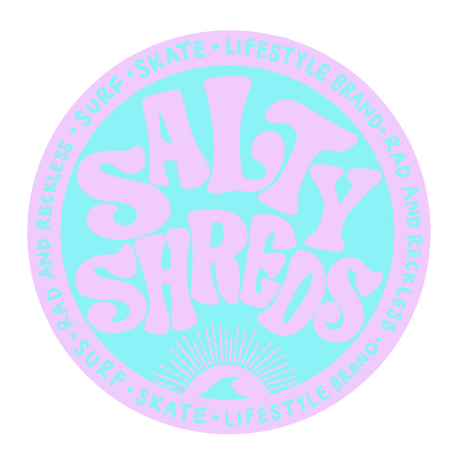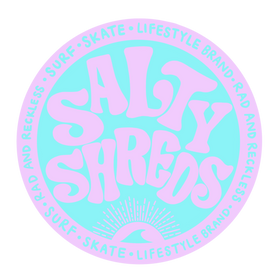Living the Salty Shreds Lifestyle!
Surf Kids Lesson 5: How to Teach your Grom The Surf Pop Up
You'll never forget the smile on your grom's face when they catch their first wave. If it's about time to hit the water, you'll focus most of your attention toward the surf pop-up.
Learning how to pop up on a surfboard with the correct techniques lays the foundation for long-term surfing success. But they're kids, and popping up isn't as straightforward as it is for adults, presenting a few intricacies to keep in mind.
If you missed the prior lessons, be sure to check out:
- Lesson 1: Introduction to Surfing
- Lesson 2: How to Read a Surf Report
- Lesson 3: Necessary Surfing Equipment
- Lesson 4: Kids' Surfboards
And if your grommets are itching to get wet, here's how to teach them (and you!!) the surf pop-up.
Step by Step: How to Pop Up on a Surfboard
After paddling into a wave, the surfer will transition their body from lying down to the standing surfing position. It needs to look like one fluid motion, free of hiccups and interruption of the legs, and that's why it's essential to build proper muscle memory off the bat.
It's better (and easier!) to form good habits than break bad ones.
Start on the sand, take these principles to the water, and practice consistency for surfing success.
1. What Stance is your Grom?
Is your grom's stance goofy foot (right foot forward), or regular foot (left foot forward)? And how can you tell?
If your kid takes part in other boardsports like skateboarding, then you already know their stance, and this won't change with surfing. But if you have no idea their surfing stance, here's a few simple ways to find out.
First, stand behind them and have them close their little eyes. When relaxed, surprise them with a gentle push forward from behind their back. Whichever leg they reach out in front to catch themselves is their front leg when surfing!
You can also try setting the surfboard down in the sand and have them stand on it. Typically, they will enter their natural stance without thinking, as it will feel most comfortable, and here are a few more ways to determine their surfing stace stance, and your own, if curious.
Right Foot Forward for My Grom! Need a Rash Guaurd for Your Surf Sesh?
2. Set the Surfboard in the Sand
Once at the beach, take some time to practice the pop-up technique on the sand. Gently set the surfboard down, and if you want to be extra cautious so as not to damage the board, remove the fins before doing so.
First, focus on their body positioning when lying down. A perfect paddling position looks like equalizing your weight between the nose and tail of the board, creating a balance that allows the surfboard to glide across the water. Too far up, and the nose will dive. Too far back, and your weight will create drag.
Every board has a unique sweet spot, and for adults, it's typically with your chest just above/equal to the middle of the board, feet over the traction pad. But a kid's body isn't long enough to reach the middle with their chest and the tail with their legs, so it's common to scoot them a bit closer towards the tail as they grow into their board.
A Note on Paddling
When lying down, adults have the arm's length to reach around the deck of their board and easily paddle.
Grom's arms are small, and they'll barely reach around the width of a wide soft top.
It's good to push your kid to paddle independently, like in the image (notice the body placement, too!), but they will need a little help paddling until they're ready for a custom surfboard or hit another growth spurt.
3. Hand Placement
A surf pop-up begins with the correct hand placement. You will position the palms of your hands on the deck of the board to initiate the push-up-like movement of the pop-up, just under the pectoral muscles.
Work with them to avoid grabbing the rails (the sides of a surfboard), and teach your groms to place their hands under their chest, using the flattened, wide base of their palms to create stability.
4. Arch the Back (Cobra!)
Just as the hands stabilize on the deck of the surfboard, arch the back by lifting your chest, engaging at the pelvis and core. You want to focus on keeping the lower half of your body connected to the board to promote stability, so the thighs shouldn't yet leave the board.
This body positioning will look very similar to the cobra pose in yoga.
Take a Moment to Practice
At this point, it's good to dial in these initial surf pop-up motions before moving forward. With the surfboard placed on the sand, have them work on placing their hands and moving into this cobra-pose-like position in one smooth motion.
5. Twist the Body, Pull the Leg
Here's a Great Exercise to Practice your Surf Pop Up at Home with your Groms!
This next part of learning how to pop up on a surfboard is where the money is made. It's the most critical and challenging part of popping up, so take time here and ensure bad habits are being avoided to the best of your ability.
From the cobra position, the goal is to swing your body around in one single, elegant motion to stand on your board. And the key? Don't use your knees to help you up!!
As soon as the back becomes arched, continue this momentum and upper body strength into the next stage of the pop-up.
Use the upper body to lift yourself off the surfboard, swing it around in a quick twisting motion, and aim to place your front foot where your hands were. As I said, don't use your knees to help you; try not to spring yourself up with your back foot.
Swing your front foot underneath you as you lift, staying low, and your back foot can gently slide/hover against the center of the board as it lands in position.
Bend your knees immediately after your feet make contact, and you can point your arms forward to stabilize.
A Note on Groms
Popping up on a surfboard takes developed upper body strength. You want to work with your surf kids on doing their best to avoid contact with their knees, but sometimes, they don't have the strength to execute to perfection.
Be mindful of reminding and helping them master this single-motion pop-up, but chances are, it will take a few growth spurts before they have the upper body strength to do it without lower-body support. It's okay if they have to use their knees!
Just focus on helping them position their front leg first, at about a 90 degree angle, before using their back knee as a pivot/support point to stand up, and then they can adjust. They can also continue to use their hands to help themselves up, as the board should be plenty stable.
The goal is to stand up and ride a wave, so let kids figure it out naturally while passing along helpful input when you can. They can work on mastering techniques as they age, so no need to take it extremely seriously.
Foot & Leg Placement
A Pretty Solid Example of Proper Leg Placement!
As soon as you stand on your board, you want to focus on foot and leg placement. Stay low and bend your knees, but try to avoid a squat-like position. We aren't sumo wrestlers, okay?
Instead, bend slightly at the front knee, and moderately angle this leg inwards (towards the tail) to support your body's weight. Point the toes toward the rail with a slight angle.
Next, twist the back leg inwards as it now bends, slightly more aggressively than the front, and point the knee forward to allow your chest and eyes to face ahead, towards the nose.
This will stylishly balance yourself in the proper surfing stance to avoid the dreaded 'poo stance', allowing you to progress into comfortably riding waves while controlling the board's direction.
Take a Moment to Practice
My advice? Have your grom (and yourself!) practice this motion repeatedly with the board stable in the sand. This allows you to critique their action, and it's easier to practice on a hard surface than on wobbly waves.
Let's Ride a Wave
After repeating the surf-pop up on the sand until engraved in their little mind, it's time to take this motion into the water.
Let me say that you do not need large waves for a grom first to learn on, and small conditions with a floaty board will allow for plenty of non-intimidating pop-up practice.
Walk them out onto a sand bar with gentle waves, and help them by pushing the board into the whitewash.
Perfect, Small Waves. Don't forget the Sunscreen :)
Advise them to wait just a second before popping up, as the board needs to connect with the wave to catch it. Be vocal, and scream loudly to pop up when the wave has fully taken them!
Do this for a handful of sessions in the whitewash to build comfortability and experience before moving into slightly larger faces. Slowly integrate their paddling in conjunction with your push as experience builds.
You'll know they've dialed in their pop-up when it looks like muscle memory, and after a while, it will be time to work on riding left & right down the open face and paddling into their own waves without your help!
Hello to all my salty people! Thanks for readin' my blog and for the continuous support towards our brand. Make sure to sign up to our newsletter by creating your account to stay in the loop with new releases, sales & giveaways, and all our future blog post!
Live rad, stay salty.
- Ash, Dev & The Salty Shreds Fam.

